
1/72 Farman F.380 Monowheel Racer
| KIT #: | |
| PRICE: | $ |
| DECALS: | Spares box |
| REVIEWER: | Chris Peachment |
| NOTES: | Made from a donor kit of the Jach Saiman 200 kit, with 10 and 20 thou plastic card. |

| HISTORY |
So far as I
know this aircraft has never been kitted before, and so is quite a rarity.
The
Farman F.380
was a French single-seat racing monoplane designed for air racing, which first
flew in 1933. It was similar but smaller than the contemporary, and more
complex, F. 370. It was powered by a 155hp Renault Bengali
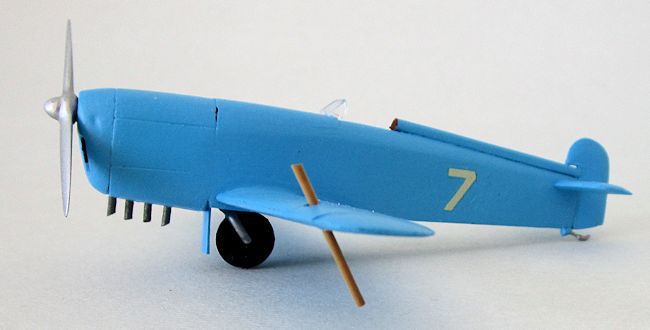 inverted
inline piston engine. Like the F.370 it had streamlined features, including a
shallow fin faired into the open cockpit headrest and fixed main monowheel
landing gear, faired beneath the engine and oil radiators.
It
was entered into the 1933 Coupe Deutsch de la Meurthe air race, where the
landing gear collapsed at the start of the race.
Before the race, however it had broken the class world speed record with a speed
of 303.387 km/h over a 200 km course.
inverted
inline piston engine. Like the F.370 it had streamlined features, including a
shallow fin faired into the open cockpit headrest and fixed main monowheel
landing gear, faired beneath the engine and oil radiators.
It
was entered into the 1933 Coupe Deutsch de la Meurthe air race, where the
landing gear collapsed at the start of the race.
Before the race, however it had broken the class world speed record with a speed
of 303.387 km/h over a 200 km course.
I
had the very nice little Jach kit of the Italian two seat biplane trainer, the
Saiman 200, which had been sitting on the shelf of doom, after a nasty accident
with the cat had crippled its undercarriage. I had been researching the history
of the French Farman company for some time, because I had realised that it a
long and proud aviation history but had been virtually neglected by all
mainstream kit manufacturers. When I came across the tiny one-off racer F. 380,
a light bulb moment occurred.
| CONSTRUCTION |
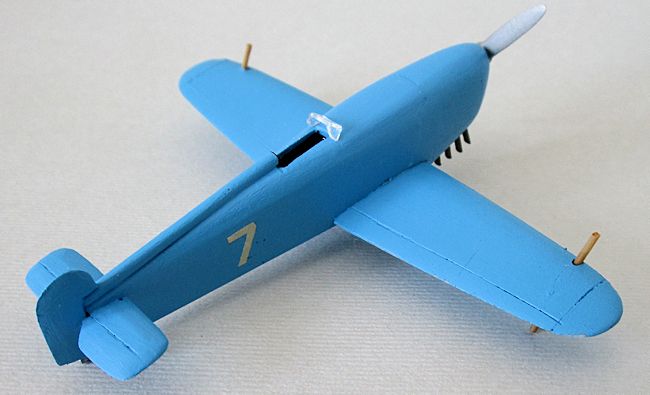 Construction
began by dismantling the sad remains of the Saiman. The nose section engine
compartment was sawn off from the fuselage with a razor saw. The remaining rear
fuselage was matched up to the plans found on a website below, and had a large
chunk sawn off its forward end, which removed the front cockpit and half of the
rear cockpit. This was then mated with the engine compartment. It was nearly a
match, with the rear fuselage edge standing slightly proud, but I left this for
the moment.
Construction
began by dismantling the sad remains of the Saiman. The nose section engine
compartment was sawn off from the fuselage with a razor saw. The remaining rear
fuselage was matched up to the plans found on a website below, and had a large
chunk sawn off its forward end, which removed the front cockpit and half of the
rear cockpit. This was then mated with the engine compartment. It was nearly a
match, with the rear fuselage edge standing slightly proud, but I left this for
the moment.
The front cockpit area was then sawn off and a chunk of 40 thou plastic inserted
into the gap. Then the tiny cockpit aperture was chain drilled into the upper
rear fuselage and cut out with a sharp scalpel. I believe there is a seat and
stick and panel inside the cockpit somewhere, but it can't be seen even with a
powerful torch. And I never go peering inside a cockpit with one of those, so
maybe there isn't. Photographs of the machine show that the pilot's head filled
the cockpit opening completely, and the edges would have decapitated him in the
event of a collision.
Sanding then
began, and went on for a good hour or two, while the area ahead of the new
cockpit was aligned with the engine cowl. The pilot's headrest has a fairing
which runs the length of the rear fuselage and this was made from plastic rod,
sanded down to a semi-circular cross section, and also tapered towards the rear
end.
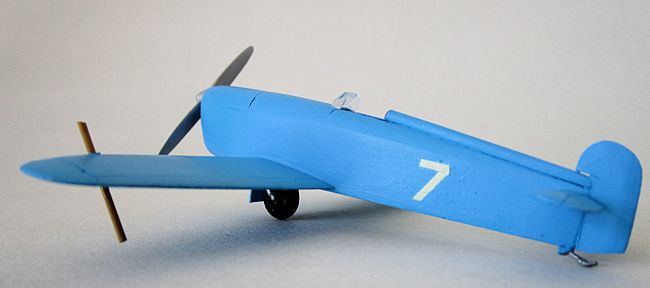 I
wondered whether to scratched build the wings with card, but decided to use what
I had left of the Saiman's wings.
Templates were cut from the plans, tacked to the wings, roughly cut up with a
large old pair of scissors, and then another hour or two of sanding produced the
right shape. New ailerons and wing
tip panel lines had to be scribed using progressive cuts from a scalpel and then
removal of the debris using an old dental pick.
A metal ruler taped to the wing surface helps here. The wing roots need
some care, as they need a gentle inward curve to fit the fuselage. Much fettling
and checking is needed here.
I
wondered whether to scratched build the wings with card, but decided to use what
I had left of the Saiman's wings.
Templates were cut from the plans, tacked to the wings, roughly cut up with a
large old pair of scissors, and then another hour or two of sanding produced the
right shape. New ailerons and wing
tip panel lines had to be scribed using progressive cuts from a scalpel and then
removal of the debris using an old dental pick.
A metal ruler taped to the wing surface helps here. The wing roots need
some care, as they need a gentle inward curve to fit the fuselage. Much fettling
and checking is needed here.
The horizontal
tailplanes can be made from 20 thou card, with elevators scribed on. And the
rudder is one piece of 20 thou, sanded down at lead and trailing edge. There is
no fin as such, and I assume that the slab sided fuselage and headrest fairing
would have ensured directional stability.
The single wheel came from the spares box, and was once a tailwheel from a much
larger aircraft, complete with yoke forks and leg. This was inserted into a
drilled hole under the engine. And
the front fairing was made of curved plastic card. The rear skid came from the
spares box.
A row of four
exhaust pipes were cut from rod, painted gunmetal on the basis that they would
not have had enough time to rust, and glued beneath the engine.
| COLORS & MARKINGS |
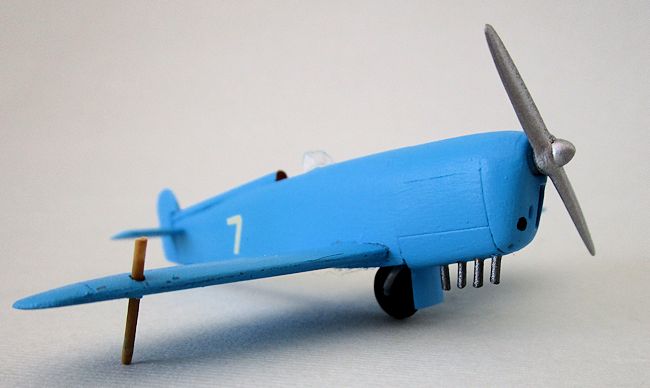 There can
be only one colour for this aircraft, and that is French Racing Blue, which came
from the Vallejo range. The number seven came from the decal remainder box. And
now comes confession time. The original has “Farman Renault” in white letters on
the nose. I tried to make my own decals for this, but at this size, they simply
came out as an unreadable white streak. Until such time as I can find a printer
which can do micro-micro-printing, then this is a model of the aircraft as it
came out of the Farman workshop, and just before it had its final markings
added.
There can
be only one colour for this aircraft, and that is French Racing Blue, which came
from the Vallejo range. The number seven came from the decal remainder box. And
now comes confession time. The original has “Farman Renault” in white letters on
the nose. I tried to make my own decals for this, but at this size, they simply
came out as an unreadable white streak. Until such time as I can find a printer
which can do micro-micro-printing, then this is a model of the aircraft as it
came out of the Farman workshop, and just before it had its final markings
added.
| FINAL BITS |
The Saiman propeller was reduced slightly in radius by sanding, and blasted with
silver. The windscreen came from
the spares box, and might possible be an old Tiger Moth screen. Incidentally, at
the outset I did consider using an Airfix
Tiger moth kit that I had for the whole thing, but the dimensions and
shape didn't quite match anywhere.
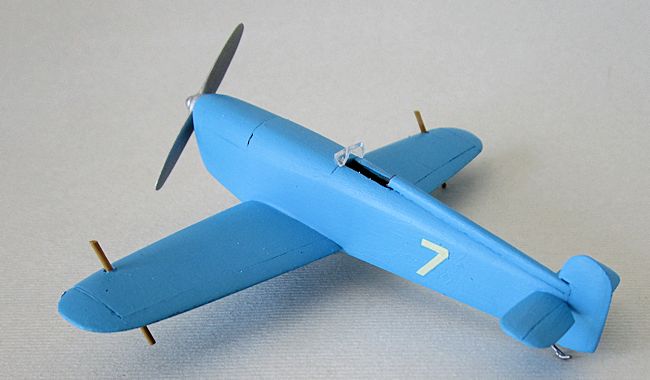 Finally
came the one feature which so charmed me about this aircraft. According to all
the photographs taken in the field of the racer at rest, the wing tip skids were
simply two sawn off broom handles, inserted into slanting holes in the leading
edge of the wing. When at rest the whole aircraft sits at a jaunty angle, rather
like a private eye's hat in a 1940s film noir.
Finally
came the one feature which so charmed me about this aircraft. According to all
the photographs taken in the field of the racer at rest, the wing tip skids were
simply two sawn off broom handles, inserted into slanting holes in the leading
edge of the wing. When at rest the whole aircraft sits at a jaunty angle, rather
like a private eye's hat in a 1940s film noir.
I drilled two slanting holes through
the wings leading edge, and inserted a couple of lengths of plastic rod,
painted wooden brown.
| CONCLUSIONS |
Not an easy build for a modeller new to scratch building, partly because of all
the sanding but mainly because of the tiny size of the sleek little beast. It
was a sore test of my creaky old fingers and foggy eyesight. Two pairs
of reading glasses were necessary for most of the build.
The
finished model is very charming, in the
unique way that all those French pre-war racers were. It would sit well
next to a Caudron Racer of the same period. The Williams Caudron Racer kit is in
1/32 which would dwarf this machine, but I believe that Dujin do a 1/72 resin
series of the racers. I am eyeing
the old Heller kit of the Caudron CR
714
fighter and wondering if major surgery might be done to it in order to...
| REFERENCES |
http://www.snipview.com/q/Farman_F.380
http://alternathistory.org.ua/gonochnye-samolety-farman-f-370-i-f-380-frantsiya
http://www.airwar.ru/enc/law1/f380.html
July 2015
If you would like your product reviewed fairly and fairly quickly, please contact the editor or see other details in the Note to Contributors.